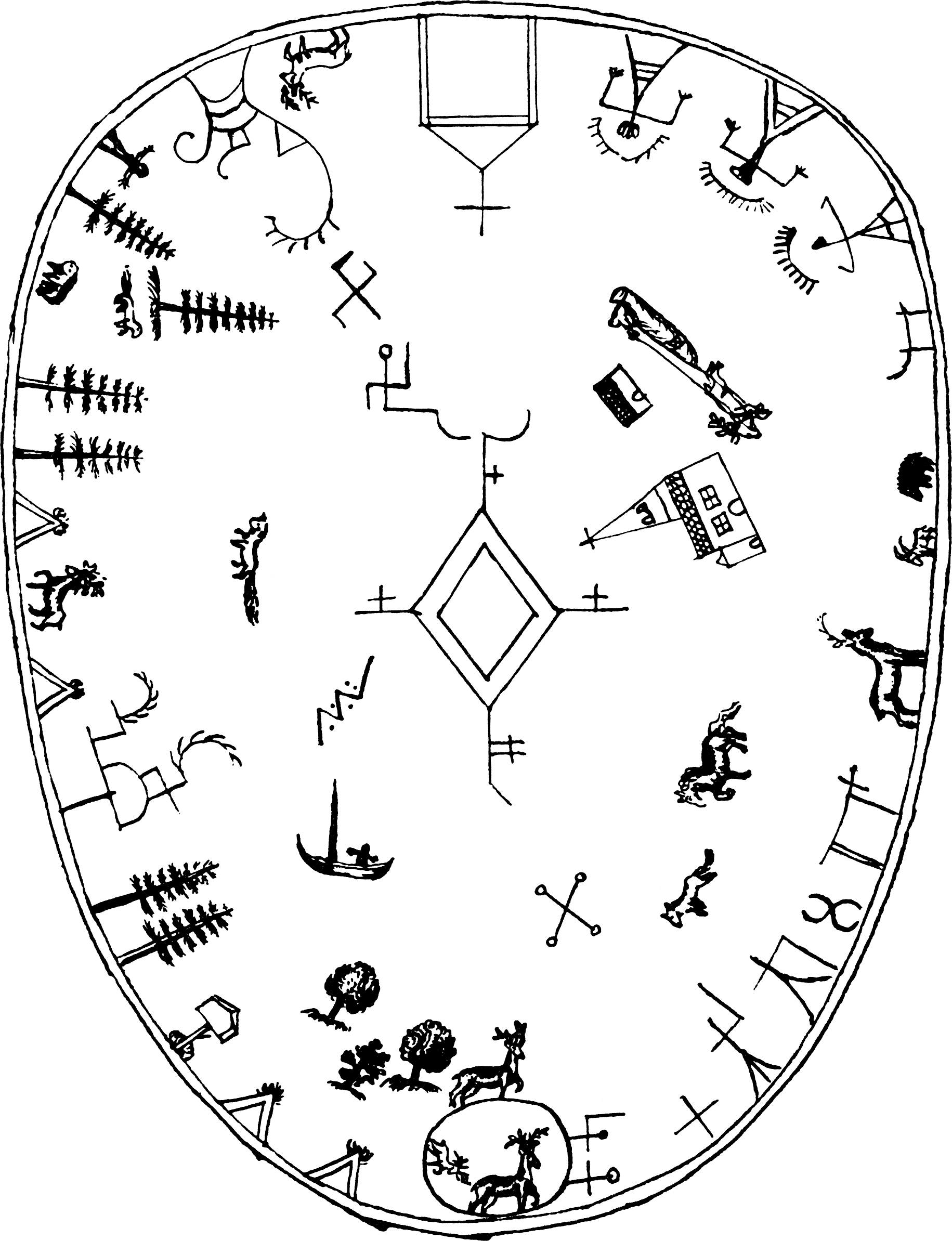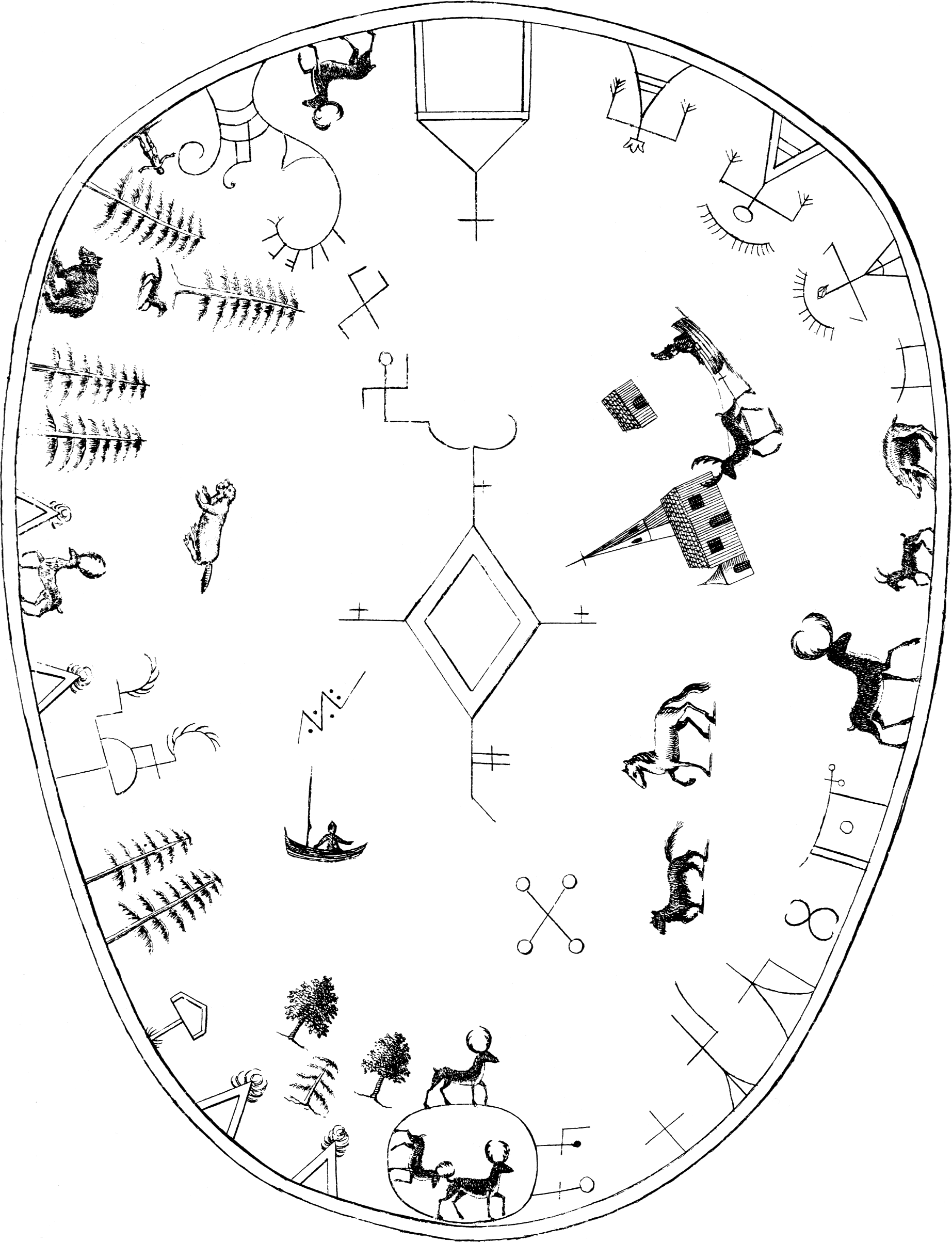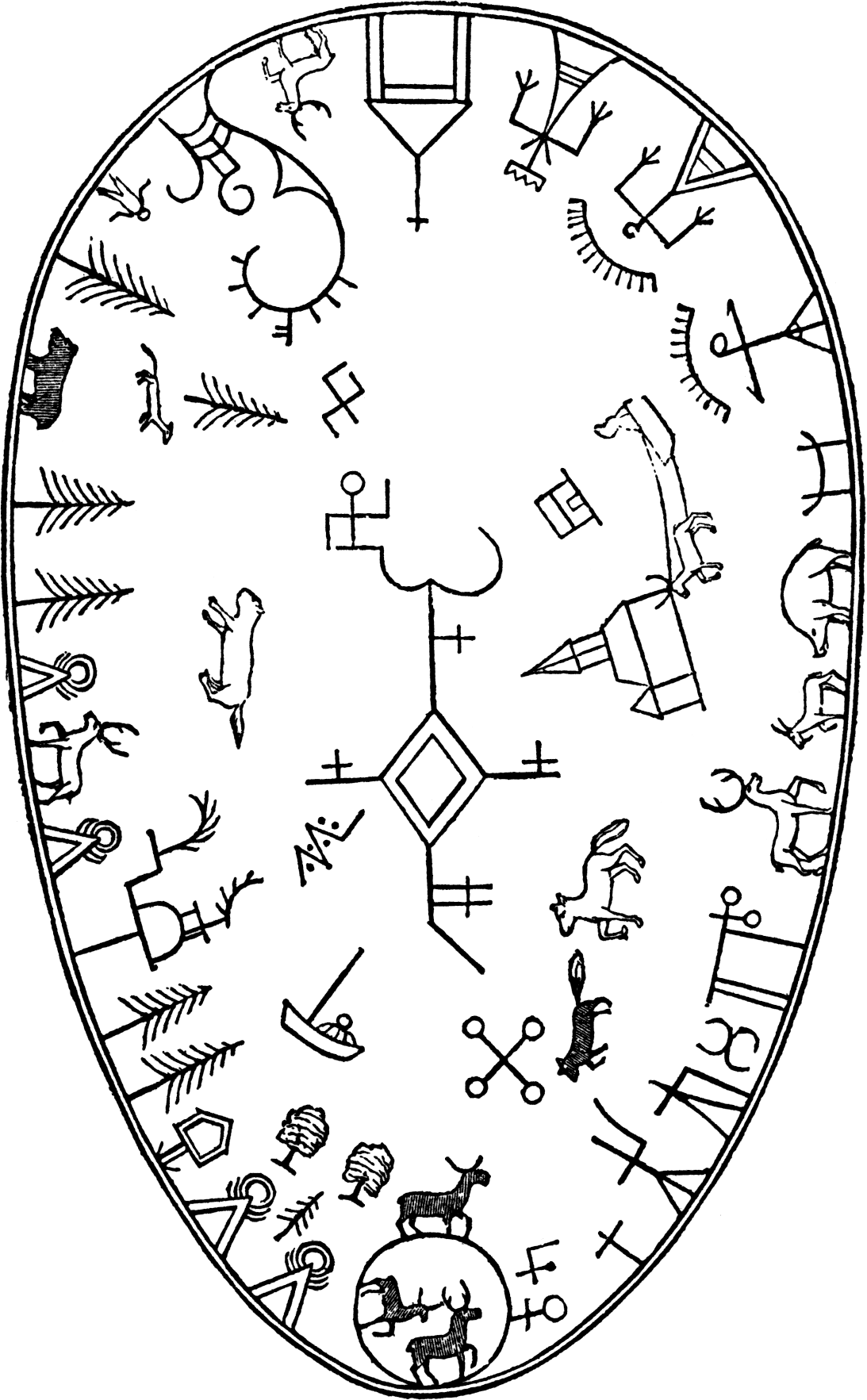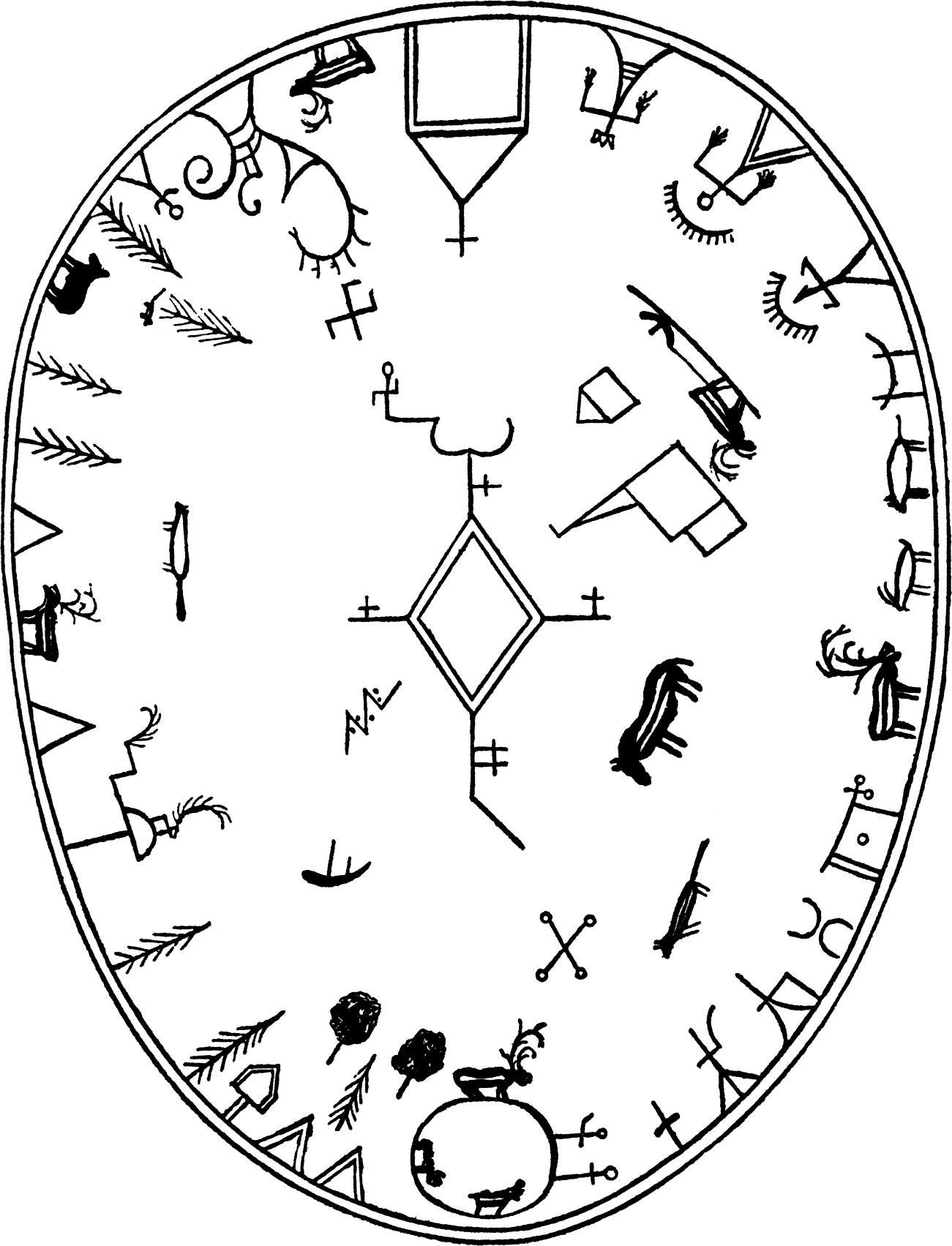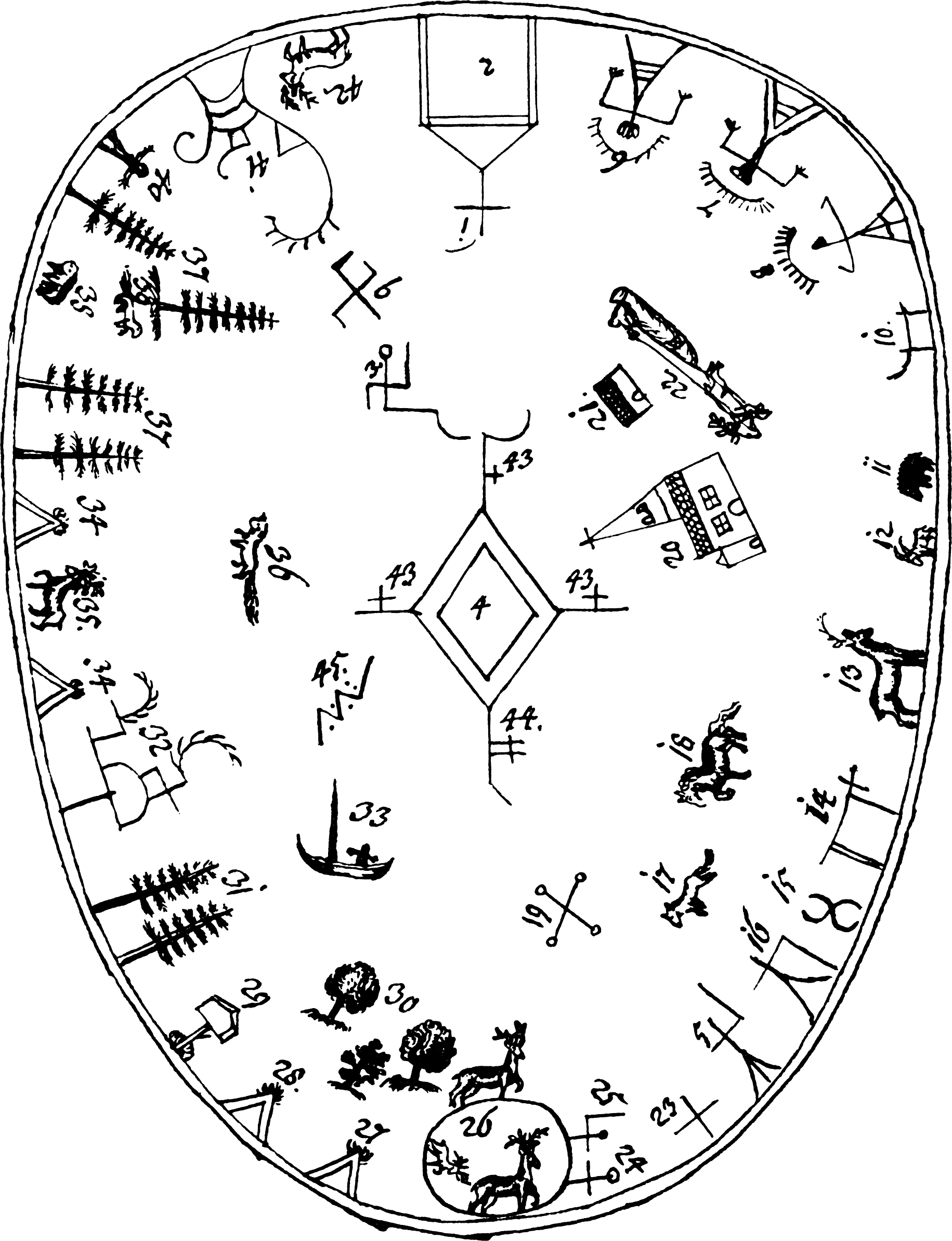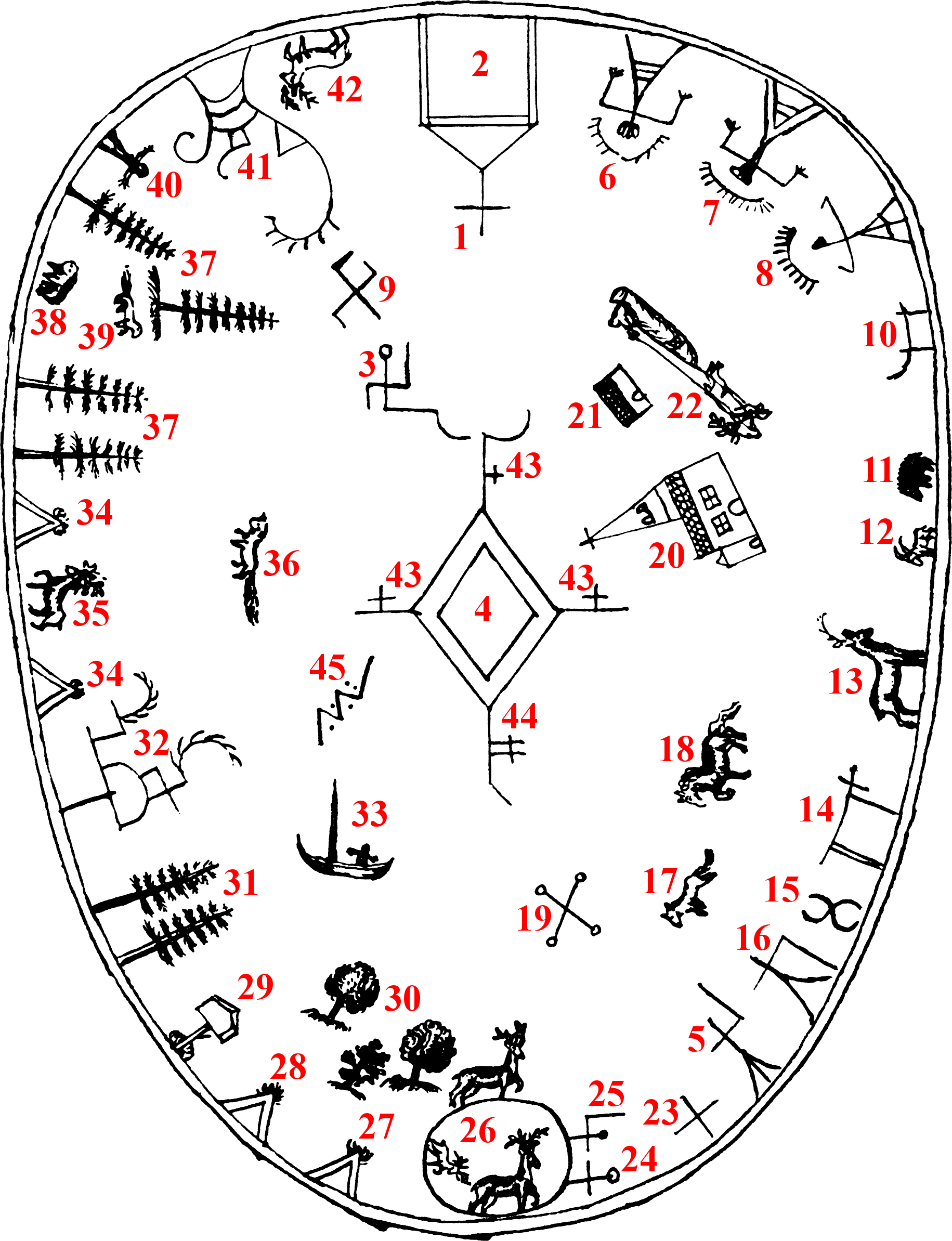A lost South Sámi drum, described by Hans Skanke in 1731
Following the death of Thomas von Westen in 1727, his papers were taken over by his colleague Hans Skanke in Trondheim. Based mainly on these papers, Skanke wrote an account of the Sámi mission headed by von Westen, which was sent to the College of Missions in Copenhagen in several installments between 1728 and 1731. Most of the text of this manuscript survives as MS Kall. 630 qv., though the accompanying maps, the first of several appendices and minor parts of the text are lost. The work is written in Danish, but is given the Latin title Epitomes Historiæ Missionis Lapponicæ (synopsis of the history of the Sámi mission). Although written in the typically awkward and overwrought style of the baroque period, it is a considerable improvement to von Westen’s own style.
The first part of the work is titled Pars prima: Anlangende de Nordske Lappers Hedendom og Superstitioner (regarding the paganism and superstitions of the Norwegian Sámis). This part is a somewhat rambling summary of Sámi religious beliefs and practices. From the beginning, the text is structured around numbered references to a drawing of a drum, but only reaches number 13 before abandoning such references and organising the narrative around the beliefs and practices rather than the drum itself, although with a few mentions of the use of the drum also in the following.
Despite the explicit reference to a drawing, no illustration is found in that part. However, appendix 3 consists of just such a drawing with symbols numbered from 1 through 45, accompanied with a list of brief explanations for each of these. Numbers 1 to 9 corresponds so precisely in all details between pars prima and the appendix that there can be no doubt whatsoever that they must refer to identical drawings, only numbered differently after number 9. Entries 10 to 13 of the longer text correspond to 24, 23, 41 and 14 respectively of the appendix, and several further entries from the list in the appendix are mentioned in the text without numerical references.
The drawing
Unfortunately, the drawing does not depict the actual design of a drum, but replaces most symbols with childish conventional drawings of the things they are supposed to represent. Due to the methods of the circle around von Westen, there is also a risk that the layout, although in general corresponding well enough to extant South Sámi drums, might be based not on a single drum, but rather represent an amalgamation of several different ones.
When Knud Leem’s Beskrivelse over Finmarkens Lapper (description of the Sámis in Finnmark) was printed in 1767, a paraphrase of the parts of Skankes work described above was added to it by Erich Johan Jessen-Schardebøll under his own name. A further distorted version of the drum drawing was included in this work, rotated 180°. Based on this again, Gustav Friedrich Klemm modified it to a style more like real drums in volume III of his Allgemeine Cultur-Geschichte der Menschheit (general cultural history of mankind) in 1844. Jens Andreas Friis did the same in his Lappisk Mythologi (Sámi mythology) in 1871, but was both more frank about the changes and the limitation this placed on the source value of the drawing, and also restored the correct orientation. As Skankes drawing survives, none of these have any additional value as sources, but having been available for study much longer they have been used as the source for earlier scholarly commentary.
The text
The exact relation between the text of pars prima and the appendix remains unclear. Their beginnings are closely related, but neither one can derive from the other alone. As the majority of the main text is irrelevant for the description and interpretation of the drum, I only present the text of the appendix here. Though briefer, it seems to cover most actual source content.
The manuscript itself does not seem to be available electronically. For the drawings I have used the reproduction in Ernst Manker Die lappische Zaubertrommel (the Sámi magic drum) volumes I and II, from 1938 and 1950 respectively. The text is taken from Ole Martin Solbergs transcription in Nordland og Troms finner i eldre håndskrifter (the Sámis of Nordland and Troms counties in old manuscripts), second fascicle, from 1945.
A detailed comparison of the text of pars prima and Jessen-Schardebølls paraphrase of it can be found in Håkan Rydving’s Samisk religionshistoria; några källkritiska problem (history of Sámi religion; some source criticism problems) from 1995.
Tredie Anhang
Runnebommens betegnelse, med sine Characterer og fortolkelse.
Designation og forklaring over Charactererne.
- Radienatzje betegnet under et simpel Kors.
- Radienkjedde betegnet under een bygning med 2de columner.
- Maderatzja betegnet under een Mands lignelse krum liggende.
- Peiwe, Soolen med sine 4re tømmer og derpaa staaende Ailikes, under betegnelse af 3de Kors.
- Maderakka staaende ex obliqvo under den den nederste Soolens tømme.
- Jubmelen-Ailes Woegni, Gud den Hellig Aand.
- Jubmelen-Barne, Guds Søn.
- Jubmelen-Atzje, Gud Fader.
- Horangalles eller Horesgusk betegnet under dobbelt Hammer.
- een Lappisk Noid vant at fare til Jamikaimo.
- 12, 13. Offer-dyr: Sviin, Gied, rein, som Runebommen skal giøre anviisning paa, ligesom Saiwo eller nogen anden Gud vil have.
- Jamik-aimo.
- Noidendirri, som Noiden bruger at sette imod afdøde Noider i Jamikaimo.
- Rutu, den onde Aand.
- Konso, Ulv, paa Nordsk Varj, som Lapperne holde for den Ondes Hund.
- Sturik, een Hest til offer for Rutu, at hand skal riide bort.
- Noidendirri, som bruges imod andre levende Noider.
- Boemands, ded er Norske folkes Kirke.
- Boemands hjem.
- Finmand i sin Kjerrest kjørende til Kirke, eller til bøygden, eller til fjelds.
- Sarakka.
- Jugsakka.
- Lappens Akka eller Kone, som i Reingierdet haver at bestille.
- Reingierdet, hvori de samle og malke deres Rein.
- Lappens og hans families Kotte.
- Sarakka Kotte.
- Lappens Stabbur eller Spisboe.
- Birke-lien og Græsslien, hvor deres Reensdyr gaae i græsning.
- Gues, granskoug.
- Fjeldet, udi hvilket Lappen paa sine tider sidder med sine dyr.
- Finne-baad, som Lappen farer til Søes udi.
- Andre Lappers Kotter, som ere hans Naboer i samme fjeld.
- Naboernes Reensdyr.
- Bjoro, Bæver.
- Tyk og stoor Granskoug, Bjørne-land.
- Biri, Bjørn, som Lapperne kalde Guds Hund.
- Laule, Maar.
- Leibolmai, Skjytter-Guden.
- Saiwo, Lappens Hellige bjerg.
- Saiwo-Sarwa, Lappens kjæmpe-Rein.
- Ailes-Olmai, Helligdagsmændene, hver betegnet med et Kors.
- Mubben-Olmai, Onde Aander, som ville giøre Lapperne ondt, paa Soolens nederste Labikje med dobbel Kors betegned.
- Guarms, Noide-Ormen, som Noiden reyser til Jamik-aimo med.
Notes on the translation
The term Runnebomme, literally “magic drum” is here simply translated “drum”. The text mainly uses the term Lapp for “Sámi”, as is typical for the period, but occasionally the older term Fin. Sometimes the two terms are used to distinguish between nomadic and sedentary Sámis, but as no distinction appears to be made by the variation here, I have translated both “Sámi”.
Third appendix
The depiction of the drum, with its symbols and interpretation.
Inventory and explanation of the symbols.
- Radienatzje depicted as a simple cross.
- Radienkjedde depicted as a building with two columns.
- Maderatzja depicted as the likeness of a man lying curved.
- Peiwe, the Sun with its four reins and standing on those Ailikes, depicted as three crosses.
- Maderakka standing diagonally under the lower rein of the Sun.
- Jubmelen-Ailes Woegni, God the holy ghost.
- Jubmelen-Barne, God’s son.
- Jubmelen-Atzje, God the father.
- Horangalles or Horesgusk depicted as a double hammer.
- a Sámi noaidi used to go to Jamikaimo.
- 12, 13. Sacrificial animals: pig, goat, reindeer, which the drum will indicate, such as Saiwo or another god desires.
- Jamik-aimo.
- Noidendirri, which the noaidi uses against deceased noaidis in Jamikaimo.
- Rutu, the evil spirit.
- Konso, wolf, in Norwegian Varj, which the Sámis regard as the dog of the evil one.
- Sturik, a horse as a sacrifice to Rutu, so that he shall ride away.
- Noidendirri, which is used against other living noaidis.
- The church of the settled man, that is the Norwegian people.
- The settled man’s home.
- The Sámi man in his sled going to the church or the settlement or to the mountains.
- Sarakka.
- Jugsakka.
- The Sámi’s Akka or wife, who has some errand in the reindeer corral.
- The reindeer corral, in which they gather and milk their reindeer.
- The Sámi and his family’s hut.
- Sarakka’s hut.
- The Sámi’s storehouse or larder.
- The slopes where birch and grass grows, where their reindeer graze.
- Gues, spruce forest.
- The mountain, where the Sámi at times stay with his animals.
- Sámi boat, in which the Sámi goes to sea.
- The huts of other Sámis, who are his neighbours in the same mountains.
- The neighbours’ reindeer.
- Bjoro, beaver.
- Dense and large spruce forest, bear territory.
- Biri, bear, which the Sámis call God’s dog.
- Laule, marten.
- Leibolmai, the archer god.
- Saiwo, the Sámi’s holy mountain.
- Saiwo-Sarwa, the Sámi’s giant reindeer.
- Ailes-Olmai, the holy day men, each depicted as a cross.
- Mubben-Olmai, evil spirits, who will bring evil upon the Sámis, on the Sun’s lower Labikje, depicted as a double cross.
- Guarms, the noaidi snake, with which the noaidi goes to Jamik-aimo.
Comments on the content
Overall, the interpretation seems to be rooted in reports from authentic traditions, if in places badly understood and forced into preconceived notions, and also containing some speculative embellishments.
1–2: That the building-like figure and the cross on top of it should represent two distinct deities seems highly unlikely to me. Crosses alone might represent anthropomorphic entities, and the same might be the case when placed atop boats, horses or the reindeer corral; but when found atop buildings, graves or building-like deity symbols, they normally merely mark these out as particularly potent in some way.
3 and 9: Several drums have one or more deities placed atop the upper beam of the sun cross though their identities are uncertain. The hammer-cross is frequently found in similar positions as here, but elsewhere it is the figure below the symbol that is identified as the thunder god, whereas the cross signifies the thunder. Normally, the thunder god is placed on the left beam of the sun, but here this position is occupied by one of the three holy day men (but see 43–44 below).
4: This interpretation is universal.
5: There are two questionable points regarding this entry.
First, it is said to be placed “diagonally under the lower rein of the Sun”, which could mean a number of figures in the lower part. However, the corresponding text in pars prima says that the line extending from the lower beam of the sun points towards it. Now such a diagonal on one side only is not found in any surviving drum, whereas a symmetrical embellished end is frequently seen; often just two diagonals just like the single one here. Even though an akka group is normally found in the lower right, the right diagonal points to other symbols just as often as in the direction of any of the akkas. Curiously, such a rightward-pointing diagonal extension is also found on another of the drums confiscated by von Westen, that of Jon Lassen. Here it points to a blank gap in the oldest drawing, but towards Sarakka in the not much younger redrawing. Any form of connection seems dubious to me.
Second, the symbol it points to, number 5, does both in style and placement correspond to what is identified as an akka group in several other drums. The problem is more which of the neighbouring symbols constitute the rest of the group, and which akka this particular symbol is meant to represent. This will be discussed further under numbers 16 and 23–25 below.
6–8: There are clear parallels to a group of three symbols of the same size to the right of Radien in Manker’s drums 6 and 13, and a group of two in his drum 1, although a single figure is much more common in this position. Whether or not such a group of three actually was meant to represent the Christian Trinity is a thorny issue. A text which Knud Leem, Henric Forbus, Lennart Sidenius and Sigvard Kildal provide different versions of states that Radien cannot be regarded as the Sámis’ equivalent of the Christian God, as some of them depict this at Radien’s side. As that text also has its origin in the circle around von Westen, this is not quite an independent piece of evidence for such an identification, but that it is not there referred to as the Trinity suggests that the comment is not based solely on the interpretation of this very drum.
11–13 and 20–21: At least 11, 12, 20 and 21 are exactly what would be expected in this part of the drum, representing the buildings and livestock of the sedentary population including a church. However, their placements differ from all parallels. On some drums, the symbols are all placed on a ristbalgr, a shared curved baseline extending inwards from the outer encircling band. In that case, the reindeer in number 13 would be quite unexpected, and one could speculate that it was rather meant to illustrate an ox. On other drums, the symbols are “floating” in the space within the outer band like 20 and 21 do here, often close to a short baseline parallel to the outer band on which there are one or more reindeer, in this case it seems unlikely that the reindeer should be interpreted just like the livestock of the sedentary populations. An example of this with a probable church, goat and pig “floating” and a reindeer on the baseline is Manker’s drum 37. Seeing all of 11–13 on the outer border is unexpected in both these groups, although a couple of drums seem to have a goat there.
22: This symbol is frequently found either in this location or further down, and either “floating” as here or on a baseline separate from the outer band.
10, 14 and 16–18: Jamikaimo or the underworld is frequently represented in the region from 10 to 14, and symbols like these two are often seen as graves or other structures found there, particularly number 14. The interpretations as a noaidi going to Jamikaimo and Jamikaimo itself looks like correct information has been provided, but has been somewhat misunderstood. Number 10 could also be a partially erased Rutu, in the form of a horse with a cross-shaped indication of a rider, which is the most frequently seen figure in this position. However, the non-mounted humanoid figure 16 is here interpreted as Rutu, which I consider somewhat dubious; more on this below. Also, number 18 is interpreted as a Sturik, a horse to be sacrificed to Rutu, which is not typically seen in addition to a mounted representation of Rutu himself. Number 17 as a wolf fits in with this “negative” theme, and possible paralles are found in several drums.
15 and 19: These are presented as two types of Noidendirri. In chapter 9 of the longer text this term is presented in a way that implies that it is similar to but distinct from gandflue, a form of sorcery sent out by a Noaidi to harm others. Symbols just like 19 is found in this position in several drums; 15 seems to have no clear parallel in shape, but a few drums has variants of the shape of 19 in positions corresponding to 15. Among those who have both is Bendik Andersen Frøyningsfjell’s drum, where these are described as two types of gandflue. The visual parallels are strong, despite the unusual shape of 15, but the interpretations differ not only in the term used, but also the nature of the two uses: dead and living noaidis in this drum, cattle and humans in the other. That the common symbol 19 represents some form of sorcery sent out to harm others is supported by other drum interpretations as well and is presumably correct, but the details remain unresolved.
16, 5 and 23–25: A group of three akka deities is very common
in this part of the drum. In more reliable accounts, these are the
sisters Sarakka, Juksakka and Uksakka, but here the
latter two are conflated, and their mother Maderakka is included
to make up for the discrepancy in numbers. The same is the case in the
interpretation of Jon Lassen’s drum, which
like this one is edited by the circle around von Westen. Skanke’s longer
text has Ugs- or Jugsakka
, showing that he knew of
both names, but considered them as variant forms and not two distinct
names. While it is possible that this is an actual variant tradition, my
assumption is that this is a misinterpretation by this group. It is also
unclear which symbols the akka group actually consists of here.
The interpretation states that it is 5, 23 and 24, which seems extremely
unlikely, as although adjacent to each other, these do not form a
coherent group visually; 24 is an obvious parallel to 25 and 5 most
likely to 16. My best guess would be that the group actually consists of
23, 5 and 16, and that 24 and 25 form parts of the complex figure
26.
26–29: A corral such as number 26 is very common on South Sámi drums,
either connected to the very bottom of the outer band as here or
floating
above it. They are drawn with one or more reindeer or
reindeer antlers on the inside and/or outside, while one or two humans
are often drawn on the outside, frequently with a stick or branch in one
hand. It is therefore very likely that 24 and 25 are part of this and
thus misattributed in the explanation. Similarly, Sámi huts are
frequently placed beside it as 27 and 28 here; the only thing unique to
the explanation here is that one of them is said to be Sarakka’s hut,
which is more doubtful. The smoke emanating from the smoke hole at the
top and the double outline must be considered embellishments, as the
huts are on other drums drawn as simple triangles. Following these is a
correctly identified elevated storehouse, only lacking the diagonal line
representing its ladder.
30–31 and 37: The last two correspond to features found on many drums, and the explanations are similar to other early sources. The first is more unique in both placement and explanation. It is therefore hard to imagine how this part may have looked on the actual drum, but it would have been quite different from the drawing.
32 and 41: These are described as mountains, the latter figure holy ones. There are parallels to such an interpretation in other early descriptions located on the part of the left edge spanned out by these two figures. However, they tend to have a characteristic shape that these two do not fully conform to, despite not being entirely dissimilar either. From its shape and position, one would perhaps imagine the second to rather be a deity, and the first possibly representing a sacrificial bench, but this must remain purely speculative.
33: Boats do occur in this region in other drums as well, although they are more common in the upper right quadrant. Some drums have a figure that is more likely to represent a skier at this location, and it could also have been this that was intended here.
34–35: The figures have parallels in other drums and the interpretation in other early drum descriptions.
36 and 38–39: The first two, the beaver and the bear, are commonly found in similar positions in other drums and identified in other early descriptions. The marten in not, but as other animals hunted for their fur are, it does not seem out of place.
40 and 42: The entities are known from the interpretation om Jon Lassen’s drum, which as mentioned above is not necessarily fully independent of this account. Similar figures occur in similar locations in other South Sámi drums.
43–44: In other interpretations, figures corresponding to the three marked 43 here are described as deities, while the holy day men are placed at the position of 44. One could imagine that the author was influenced by the account of Jon Lassen’s Ume Sámi drum, as the holy day men occupy this position on that drum, but the longer description in Schanke’s text is at odds with this in that the saturday and sunday men have switched sides, and the terms for the individual men are different. Here the top one (sunday) is called buores-ailikes, the one on the right (saturday) Lava-ailikes and the one on the left (friday) Frid-ailikes.
45: The term Guarms is here used in error for Guelle, but the function it is given is correct. The reason for the mix-up can be seen in the longer text. In chapter 5, three important tutelary spirits all noaidis have are listed: Saiwo-Wuornis-Laidde (a bird), Saiwo-Guelle (a fish or snake) and Saiwo-Sarwa (a reindeer bull). When these are referenced in chapter 9, they are written Guarms, Noide-guelle and Noide-Sarwa. It seems that Guarms here might be a variant of Wuornis, especially as the term is spelled Guorms in the chapter heading.
